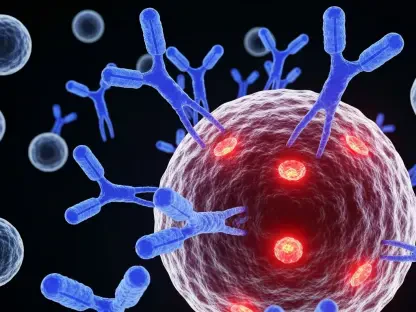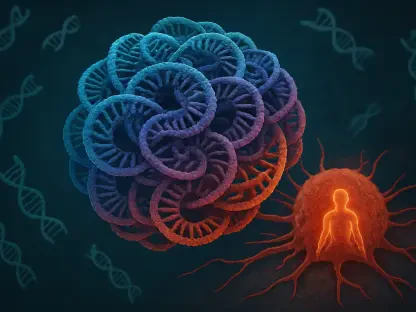In recent years, advancements in allergy treatment have shifted towards a comprehensive understanding of immunological components that drive allergic reactions, particularly IgE antibodies. As allergens infiltrate the body, IgE antibodies are produced by white blood cells, instigating a cascade of histamine release and inflammation that defines allergic responses. Traditionally, these reactions were managed with antihistamines and steroids, temporarily alleviating symptoms without addressing underlying causes. Severe allergy sufferers relied heavily on allergen avoidance as a primary strategy, limited by the lack of more effective approaches. However, novel insights into IgE’s persistence in the body promise dynamic shifts in allergy treatment landscapes.
Unveiling the IgE Antibody Mechanism
The Role of IgE in Allergy Development
At the core of allergic reactions, IgE antibodies illustrate the complex interplay between immune system components and external allergens. Their formation ignites when white blood cells encounter allergens, leading to a cascade marked by histamine release. Traditional treatment methods targeted these symptoms using antihistamines and steroids, focusing on mitigation rather than eradication of allergic responses. This paradigm shift began unraveling through the insights of researchers like Jamie Orengo. Her team hypothesized the presence of allergic memory—an immune system phenomenon where exposure to allergens results in long-lasting preparatory responses for future interactions, perpetuating allergic reactions even after significant time. This innovative concept laid the foundation for investigating IgE’s role more deeply and strategizing towards complete allergy relief.
Class Switching and IgE Production Pathways
Key discoveries in the field have revolved around differentiating IgE-producing cells from typical B cells, challenging conventional understanding. Maria Lafaille’s significant contributions highlighted that these IgE-producing cells do not undergo standard differentiation like most B cells. Her findings suggest that IgE plasma cells derive from IgG memory B cells through a process known as class switching. Such revelations necessitated a deeper investigation into the molecular characteristics promoting IgG memory B cells’ transition to IgE plasma cells. Recent studies have identified distinctive features that bias these memory B cells towards potentially pathogenic IgE plasma cell paths. This sparks the intriguing potential for blocking pathways or processes, inhibiting new IgE cell formation, and offering a promising avenue for comprehensive allergy eradication.
Targeting Long-Lived IgE Plasma Cells
Discovery of IgE Persistence
Despite dupilumab’s significant efficacy in disrupting IgE signaling pathways, challenges persist with IgE’s prolonged presence. The assumption was initially that IgE plasma cells were short-lived, simplifying early research outcomes focused on inflammation models. However, Jamie Orengo’s investigation into chronic allergic conditions, particularly in HDM allergy models, revealed surprising accumulations of IgE plasma cells within the bone marrow after long allergen exposure periods. This observation suggested the potentiality of a subpopulation of IgE plasma cells possessing extended survival traits. Such revelations explain the shortfall of current therapies in wholly eliminating IgE, meriting Marcus Robinson’s advocacy for genetic timestamping to ascertain IgE plasma cell lifespans definitively.
Innovative Bispecific Antibody Approaches
As innovative solutions emerge, aspirations intensify towards eradicating IgE production. Andre Limnander from Regeneron spearheads efforts capitalizing on bispecific antibody technologies targeting BCMA on plasma cells, inducing T cell-mediated cytotoxicity. Borrowed from oncological developments, this approach, combined with dupilumab’s capabilities, potentially enables wide-scale plasma cell elimination, obstructing subsequent regeneration through class switching. Early experimental results showcase promising progress, where near-total IgE removal was achieved in chronic exposure models, further validated through trials involving both non-human primates and human samples. This consolidates the foundation of new therapeutic strategies aiming to efficiently target long-lived IgE sources while preventing ongoing class switching, redefining allergy treatment boundaries.
Advancing Towards Holistic Allergy Solutions
Broadening Investigation to Various Allergies
As scientific endeavors expand, there’s a growing interest in translating these findings into wider allergy contexts, including food allergies. Regeneron is advancing into Phase 1 clinical trials to evaluate the safety and efficacy of the combination therapies, seeking revolutionary progress in comprehensive allergy management. This enthusiasm emphasizes not only the potential to transform strategies against severe allergic reactions but also sets the stage for broader applications impacting diverse allergy forms. By eradicating lingering IgE antibodies and preventing future production, efforts aspire towards durable relief for individuals tormented by persistent allergies.
Redefining Allergy Management Possibilities
The emergent narrative in allergy treatment extends beyond merely adjusting symptoms, evolving towards true eradication of the underlying causes. The once-distinct lines between managing symptoms and complete elimination are blurred through rigorous research and breakthroughs surrounding IgE antibodies. Such advances foster optimism for those enduring severe allergic reactions, heralding a future where therapeutic solutions offer relief without the constant specter of relapse. As the scientific community perseveres in translating these findings into holistic solutions, there is palpable enthusiasm over these potential transformations, promising significant enhancements to the quality of life for allergy sufferers.
Paving the Path for Future Allergy Treatments
In recent years, there has been significant progress in allergy treatment, focusing on a deeper understanding of the immunological processes responsible for allergic reactions, especially those involving IgE antibodies. When allergens enter the body, IgE antibodies are produced by white blood cells, triggering the release of histamine and causing inflammation, which are hallmarks of allergic responses. Traditionally, such reactions were managed with antihistamines and steroids, which provided temporary relief from symptoms but failed to tackle the root causes of allergies. For those experiencing severe allergic reactions, avoiding allergens was primarily their only recourse, limited by a lack of more effective treatment options. However, recent advancements have provided new insights into the persistence of IgE antibodies in the body, offering hope for more effective allergy treatment strategies. Scientists are now exploring ways to modify the immune response directly, potentially leading to long-lasting relief for allergy sufferers. This marks a dynamic shift in the landscape of allergy treatments, where future therapies may go beyond mere symptom management to actually altering the course of allergic diseases. This new understanding could significantly improve the quality of life for those afflicted by chronic allergies.









